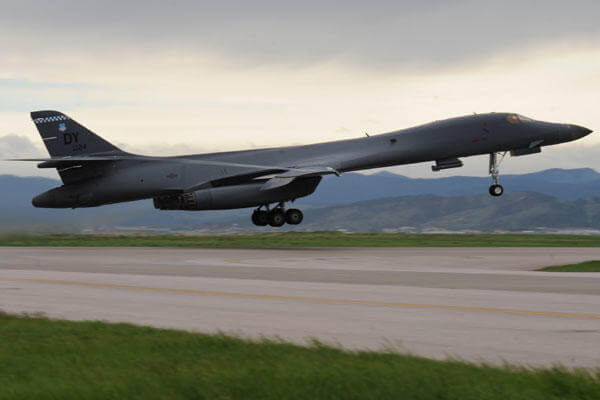Five U.S. Special Forces troops and an Afghan soldier were killed Monday in a friendly fire incident reportedly involving bombs dropped by a U.S. Air Force B-1B bomber supporting a close air support mission.
"The casualties occurred during a security operation when their unit came into contact with enemy forces," the International Security Assistance Force said in a statement.
"Tragically, there is the possibility that fratricide may have been involved," ISAF said of the incident that occurred during a counter terror mission in southeastern Zabul province near the Pakistan border.
At the Pentagon, Rear Adm. John Kirby, the Pentagon press secretary, said: "We do have reason to suspect that friendly fire was the cause here, specifically friendly fire from the air."
Kirby declined to confirm several reports that the airstrike called in to back up the troops was from a U.S. Air Force B-1B bomber. However, the tragedy was likely to re-ignite the debate in Congress over the Air Force's plan to retire the A-10 Thunderbolt – for decades the military's premier close air support platform.
Kirby said he could not comment on the circumstances of the airstrike pending an investigation, but stressed that "there's been no change in our position" as a result of the incident that the A-10 fleet should be retired.
"To draw the line between this incident and our desire to retire an aging platform is a bit of a leap," Kirby said.
Several members of the House and Senate have been arguing against the Air Force's decision to cut funding for the A-10 from the National Defense Authorization Act.
Sen. John McCain, R-Ariz., said last month that the aircraft was an infantry favorite.
"We listened very carefully to the U.S. Army," McCain said of the A-10 supporters. "They are the ones who need the close air support, they are ones who are in grave danger without it."
The effort to save the A-10 suffered a major setback Tuesday when the House Appropriations Committee voted to scrap the A-10. The vote by the committee was 23–13 against an amendment to the annual defense spending bill that would have preserved funding for the A-10 in the Fiscal Year 2015 budget.
The five U.S. troops and at least one Afghan soldier who were killed were taking part in a security operation in the Arghandab district of Zabul province, one of many security sweeps currently being conducted by U.S. and Afghan National Security forces ahead of a presidential runoff election scheduled for Sunday.
Provincial Police Chief Gen. Ghulam Sakhi Rooghlawanay told the Associated Press that after the operation in Arghandab was completed joint forces came under attack and "foreign forces" called in air support.
"Unfortunately, five NATO soldiers and one Afghan army officer were killed mistakenly by NATO airstrike," Rooghlawanay told the AP.
The deaths brought the number of U.S. troops killed in Afghanistan this year to 35, compared to the 71 killed in the first six months of 2013. Defense analysts and former pilots pointed out that close air support missions are some of the most dangerous to fly, no matter if an A-10 or a B-1 flies them.
However, B-1s were not designed for close air support missions, the aircraft was built for long range bombing missions during the Cold War. The A-10 was designed for danger close fire. The most recent incident has left A-10 supporters saying potential friendly fire incidents could be avoided if A-10s remain in the Air Force fleet.
The tragedy Monday was possibly the worst friendly fire incident involving NATO forces of the war. In April 2002, four Canadian soldiers were killed when a U.S.F-16 dropped a bomb in Kandahar province.
In August 2007, three British soldiers were killed when a U.S. Air Force F-15 Eagle hit their position with a 500-pound bomb during a firefight with Taliban fighters in southwester Helmand province.
-- Richard Sisk can be reached at richard.sisk@monster.com





























